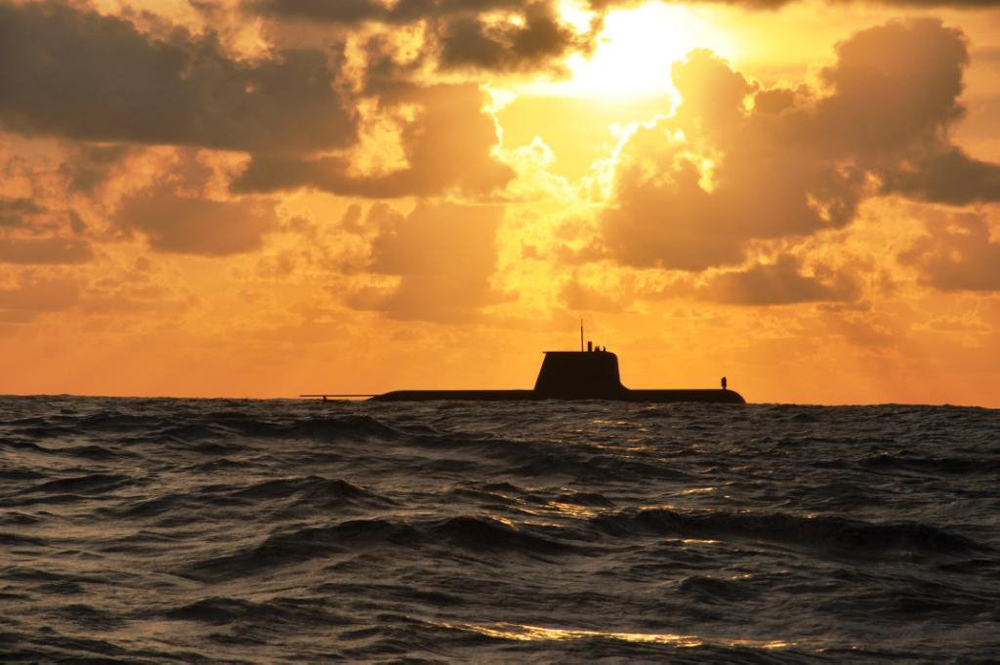 The record of the RAN’s Oberon- and Collins-class submarines shows that diesel-electric submarines can perform valuable long-range operations. However, Australia’s range and endurance requirements are much closer to the operating profiles of other nations’ nuclear-powered submarines (SSNs) than they are to those of any existing conventional boat. The case for acquiring an SSN will become even stronger as other regional navies—in particular, China but also India—begin to operate such boats more regularly in our region. So it’s unsurprising that suggestions for moving to a nuclear submarine keep popping up. And unlike its 2009 and 2013 predecessors, the 2016 Defence White Paper doesn’t explicitly rule out nuclear propulsion from consideration.
The record of the RAN’s Oberon- and Collins-class submarines shows that diesel-electric submarines can perform valuable long-range operations. However, Australia’s range and endurance requirements are much closer to the operating profiles of other nations’ nuclear-powered submarines (SSNs) than they are to those of any existing conventional boat. The case for acquiring an SSN will become even stronger as other regional navies—in particular, China but also India—begin to operate such boats more regularly in our region. So it’s unsurprising that suggestions for moving to a nuclear submarine keep popping up. And unlike its 2009 and 2013 predecessors, the 2016 Defence White Paper doesn’t explicitly rule out nuclear propulsion from consideration.
The apparent good fit of a nuclear capability needs to be balanced against what’s feasible today, given Australia’s industrial, engineering and regulatory capacity, the cost of nuclear submarines and their supporting infrastructure, the availability of technology, and public attitudes about nuclear energy. After a lengthy struggle, Australia now has the elements needed to manage its fleet of conventional submarines in place, but little experience or capacity for providing the additional fundamental inputs to capability needed to support nuclear-powered submarines. The time to put these pieces in place for the Collins-class replacement has long passed. The announcement of a continuous acquisition model for Australia’s submarines in the 2016 DWP, however, does raise the question of whether that program will always and forever be based on conventional propulsion.
In principle we could acquire nuclear reactors for submarines—the transfer of marine nuclear propulsion systems is allowed under the Nuclear Non-Proliferation Treaty. But it’s not clear that even our closest allies would necessarily assist our efforts. We’d need to demonstrate a clear strategic rationale for such a step, backed with a long-term strategic and industry relationship. And we’d need to engender confidence that Australia was successfully developing the ability to operate and maintain nuclear-powered submarines to the highest standards of safety. No supplier would want to risk the reputation and domestic political support of its own domestic nuclear submarine capability through an accident caused by the Australian Navy. Naval engineering in RAN and Australia’s wider nuclear engineering expertise are today almost certainly far below the levels of capacity and sophistication that a supplier would expect before even considering a transfer of nuclear reactors.
Regular surveys and maintenance of every component of reactor machinery (some radioactive) are essential elements of the maintenance cycle of an SSN, requiring an expert nuclear-trained workforce. Even if major refits and refuelling of Australian nuclear-powered boats could be done offshore, routine maintenance would still place considerable demands upon local support facilities. The safe design, construction, operation and maintenance of SSNs therefore depend on extensive understanding and experience of the underpinning science and engineering. Operating naval reactors would require a significant expansion of Australia’s nuclear establishment writ large, including academia, industry, ANSTO, ARPANSA and the Navy itself.
Given time, there’s little reason why Australia couldn’t make nuclear propulsion a realistic option for future generations of its continuous submarine acquisition program. SSNs are more expensive to acquire and operate than conventional submarines, but a decision to acquire them would be only taken because the strategic environment demanded it. Building the successor to the Collins-class should significantly strengthen Australia’s expertise, capacity and reputation in submarine technology. Bipartisan support for acquisition of SSNs would be needed, but the South Australian Royal Commission shows that the politics of nuclear industry more broadly are shifting. And the 2016 White Paper does mention a review of the ‘specifications’ of Australia’s submarine design in the late 2020s in light of developments in the strategic environment and technology.
However, to make the acquisition of SSNs a realistic option, Australia would need to enhance its cadre of experts and engineers well before such a decision is even seriously contemplated (both to ensure that we’re an intelligent buyer and to be seen as a competent possible operator). Today, we have a small national cadre of technicians in support of the sole Australian nuclear reactor at Lucas Heights, but that’s a far simpler design. It’s true that modern nuclear submarine technology is more ‘user friendly’ than it used to be. For example, some modern reactors will run for the lifetime of the submarine on their initial fuel, greatly simplifying a part of the maintenance cycle. But each of the three possible suppliers of propulsion reactors—France, Britain and the US—has taken different approaches to the reactor design, and we’d need to have the expertise to assess the advantages and disadvantages of each in Australia’s particular operating environment and industrial landscape.
Being able to consider SSNs in the late 2020s thus wouldn’t be a small step; it’d require Defence to start spending money to build up Australia’s cadre of nuclear engineers, to reach out to ANSTO and ARPANSA, and for government to make the case for considering SSNs to the Australian public. A first step could be a study to examine the broader implications of even studying nuclear propulsion for Australia and its nuclear establishment and workforce, including the necessary regulatory (and perhaps voluntary safeguards arrangements) that would need to be put in place. So there’s a cost to making an SSN a realistic option. But as Australia’s strategic environment continues to become more challenging, it might be money well spent to set up Australia’s underwater capability for the future.

